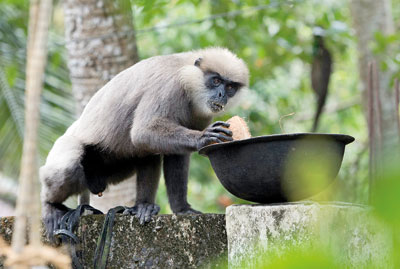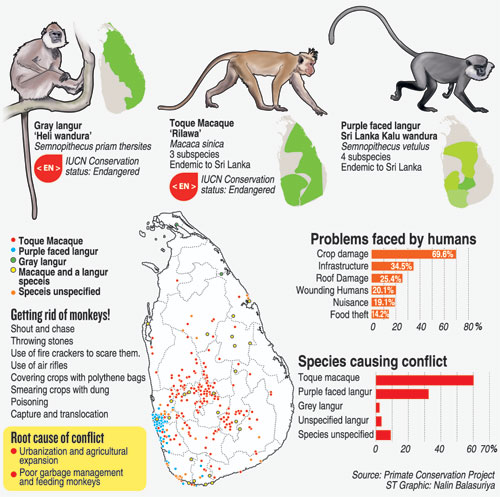News
Don’t monkey around with our monkeys

Having a feast: Coconuts and bananas not spared. Photos by Rukmal Rathnayake
As monkeys struggle for existence while causing havoc to the people with their monkey tricks, the need to co-exist with our closest animal kingdom relatives was emphasised at an international conference here.
The Toque Monkey, better known as the Rilawa, causes more trouble than the Purple-faced Leaf Monkey or Kalu wandura, according to studies.
The Fifth Asian Primate Symposium hosted by the Sri Jayewardenepura University was held at the Mount Lavinia Hotel with seven countries participating to discuss ecology, biodiversity, human-animal conflict and related issues of interest to Asian primatologists.
An analysis of around 500 monkey-related complaints received by the Department of Wildlife Conservation (DWC), from 2007 to 2015 was presented at the conference by Dr. Tharaka Prasad, the DWC’s chief veterinary surgeon. According to him, 54 percent of the complaints have been against Rilawas and 29 percent against Kalu Wandura. Both these species are endemic to Sri Lanka.
Colombo which records the highest human population density had the highest frequency of conflicts of 115. Sadly, most of these are against the Kalu Wandura which is closed to the risk level of the Critically Endangered Western Purple-faced langur. Its conflict with humans severely undermines its future survival. Sri Lanka’s western region, where these langurs mainly stay, has only a few forest patches and the remaining habitats are also being lost or degraded. There are only a few protected areas, under the control of the DWC in the Western region, adding to the challenge of conserving these highly arboreal langurs.
Dr. Prasad who frequently treats injured monkeys said: “Monkeys are social animals. So we get into really difficult situations as to what we should do for the injured animals after they recover.”
At present, such monkeys are released to a location closer to Colombo as there is no alternative. There is a plan to build a facility to keep such monkeys, he said.

Sri Lanka is home to two other primate species — the Grey Langur and Slender Loris. Slender Loris monkeys stay mainly on the trees and rarely make contacts with humans. Even where Grey Langurs or hanuman monkeys are concerned, the number of human-animal conflicts is negligible.
According to the analysis, about 70 percent of the complaints relate to crop damage. Several other primate scientists, both local and international, made presentations at the symposium. A strategy to conserve and coexist with Sri Lanka’s monkeys was also presented in a paper prepared by Dr. Rudy Rudran of the Smithsonian Institute. Dr. Rudran’s research team is conducting an islandwide survey to identify important issues relating to monkey troubles.
Local researchers Surendranie Cabral, Sanjaya Weerakody and Rukmal Ratnayake say the utcome of this research may help to identify factors and reduce conflicts or tension between humans and monkeys.
Instead of viewing this situation in the grim terms of monetary losses due to the conflict, it should be seen as a challenge to the science of conservation biology, where coexistence of humans and monkeys is the key to conflict resolution, the symposium agreed.


